Description
There are sixteen Native American murals in the lobby of the United States Post Office in Anadarko painted by Kiowa artist Stephen Mopope. These depict Kiowas in various scenes and were the result of a Section commission. Since Anadarko lies within the Kiowa Nation, Mopope’s selection as artist is particularly appropriate, he is generally given full credit for the Anadarko cycle although the Treasury Department Art Projects bulletin[1] stated that Asah, Auchiah, and Tsatoke assisted in the creation. This is an understandable statement considering the extensive work required for the sixteen murals and the cycle is undoubtedly on of the largest commissions for a post office. Mopope created a near compendium of the imagery he had favored since he began his art career in the late 1920s. His career as a dancer and his experiences on the powwow circuit most likely prompted the inclusion of several dance images. These subjects were within Mopope’s repertoire, and many of the Anadarko images bear a close similarity to prints in the Kiowa Art portfolio. [4]
- Two Eagle Dancers
- Fancy War Dancer with Cedar Flute
- Scalp Dance (Drum Chief Standing)
- Individual War Drummer (Sitting)
- Eagle Whip and Flute Dancers
- Two Women and Child Watching Dancers
- Two Men in Council
- The Deer Hunter
- Kiowa Moving Camp
- Kiowa Camp
- Buffalo Hunting Scene
- Indian Mother and Child in Cradle
- Medicine Man’s Shield and Lance
- Buffalo Hunter’s Shield
- Buffalo Skull with Crossed Arrows
- Buffalo Head
Stephen Mopope – Artist
Stephen Mopope, was born August 27, 1898 on the Kiowa Reservation located within Indian Territory. He was given the Kiowa name “Qued Koi,” translated into “Painted Robe,” and was born from a mixed ancestry of Kiowa of his mother’s bloodline and Spanish from his grandfather, who was a captive adopted into the tribe. As a young boy, Mopope, was observed to be a natural artist drawing pictures in the sand, so family members taught him the tradition of painting on animal hides and tipis. Painting on hides was the foremost method used by tribal communities to record historically significant events known as “Winter counts” for the time of year they were created. The Kiowa differed in creating two per year versus one, which would give a more detailed account of their history. During the early reservation period of the 20th Century, education for Indian children was mandated through Federal boarding and mission schools where the children learned basic skills in English, math, and in this case, art. Stephen Mopope was one of the young Kiowa artists who showed promise and enthusiasm in developing new skills after receiving a limited education in art at the mission schools. Mopope and five other developing Kiowa artists, including a female, Lois Smoky, who later left the program, were brought to the attention of Oscar Jacobson, Director of the Art program at the University of Oklahoma from 1915-1954. Through their training and guidance under Jacobson, the artists progressed and became known as the “Kiowa Five,” adhering to traditional motifs using their limited early training to pioneer the “Flat style.” The “Flat style,” was named for its lack of depth, which held the historical integrity of hide and tipi paintings used to record tribal events and became the most recognizable and defined style of Native American artists until the 1960s when they began to redefine art as individuals, breaking away from the traditional style.
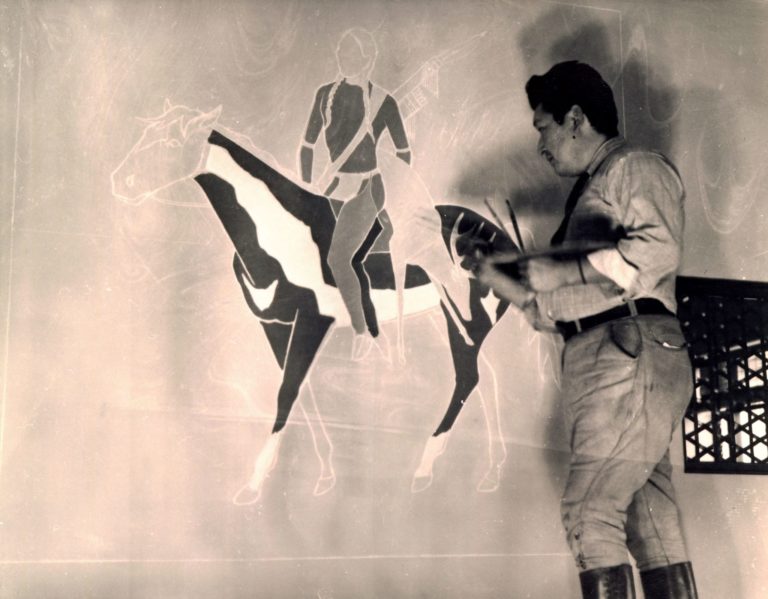
In June 1936, Oscar Jacobson, who was in charge of WPA projects for Oklahoma, commissioned Mopope, assisted by “Kiowa Five” associates James Auchiah and Spencer Asah, to undertake the task of painting 16 murals in the newly constructed post office in Anadarko, Oklahoma. Mopope was also chosen because he was considered by Jacobson to be the best and most outgoing artist of the “Kiowa Five,” a trait which necessary to becoming the lead for the project. His cultural ties to Anadarko, home to the Kiowa, would provide an accurate depiction of the culture from his personal experiences. Mopope was also chosen as one of the few Native artists to paint murals in the new Department of Interior building in Washington, DC, home office the Bureau of Indian Affairs, after it was constructed in 1936. Having come from a line of tipi artists, Mopope had experience in creating large mural like paintings coming from a line of artists who produced hide and tipi paintings. Mopope’s artistic lineage included two of the most influential and visible Kiowa artists of the time within his family which included his great uncles Silver Horn or “Haungooah,” and Oheltoint. Silver Horn was one of the most recognizable Kiowa artists from 1850-1900 when their nomadic way of life came to an end and the reservation era began. Oheltoint was a prisoner of war at Ft Marion in St. Augustine, Florida at the end of the Red River Wars in 1875 and one of the artists who helped pioneer the Indian “Ledger style” of art popular from the 1860’s until the 1920s which was also influential within the ‘Flat Style.”
The origins of Native American art are not known, but the subjects have continuously been symbolic in nature recording aspects of everyday life, important events, and religious beliefs. As a young boy, Mopope learned the significance of recording those memories and the role they play within Native culture through the guidance of his great uncles Silver Horn and Oheltoint. Art was not originally created for its aesthetic qualities, but as a way to capture all the separate elements of life together representing the holistic view of Native people. Mopope was influenced through his experiences as not only an artist, but as an accomplished dancer and flute player providing another way of expressing himself through his culture.[2]
The Deer Hunter
Tells the story of a hunter returning with deer, but only after an extremely long trek, since game is scarce.
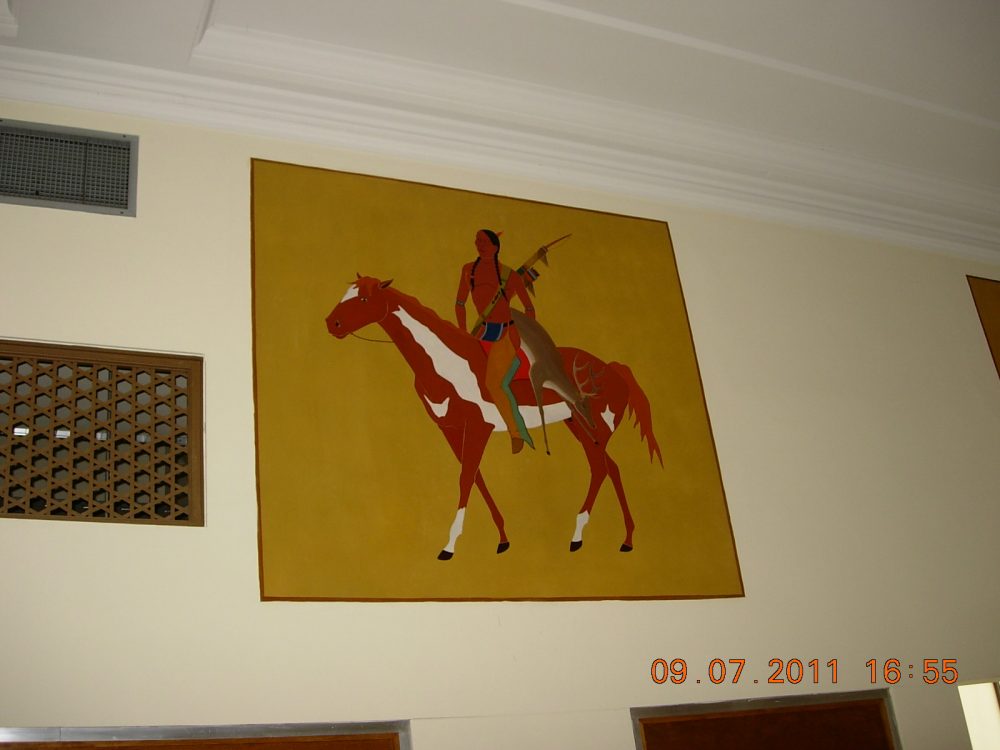
Eagle Whip and Flute Dancers
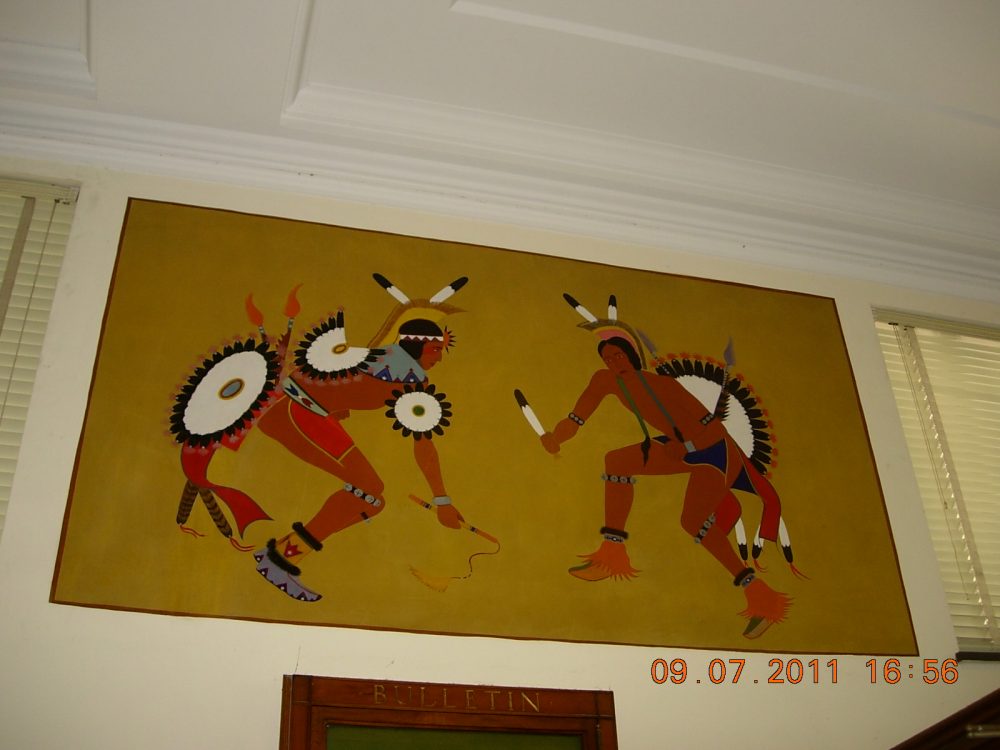
Medicine Man’s Shield and Lance
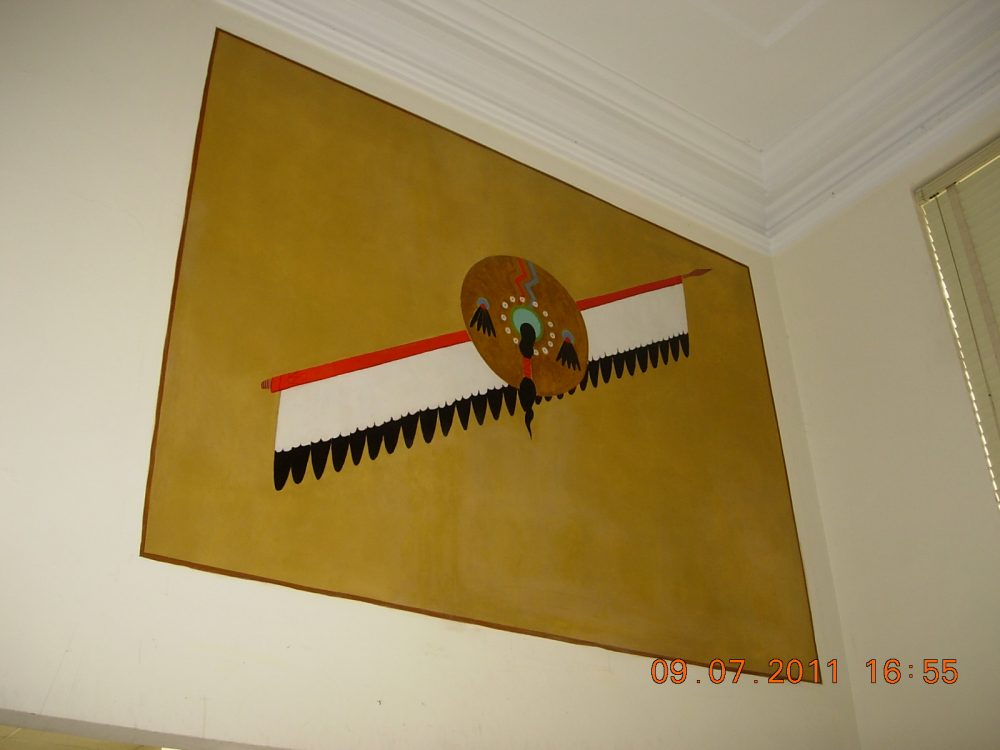
Two Men in Council
“Two Men in Council” is a painting to help remind us of the Sun Dance. The man holding the ceremonial fan is the chief of the Sun Dance. The Sun Dance was traditionally held each summer, before the buffalo hunts to insure a good supply of meat and materials for the winter months. Both men have their braids wrapped, a ceremonial sign, and both wear leggings and hats decorated with a feather.
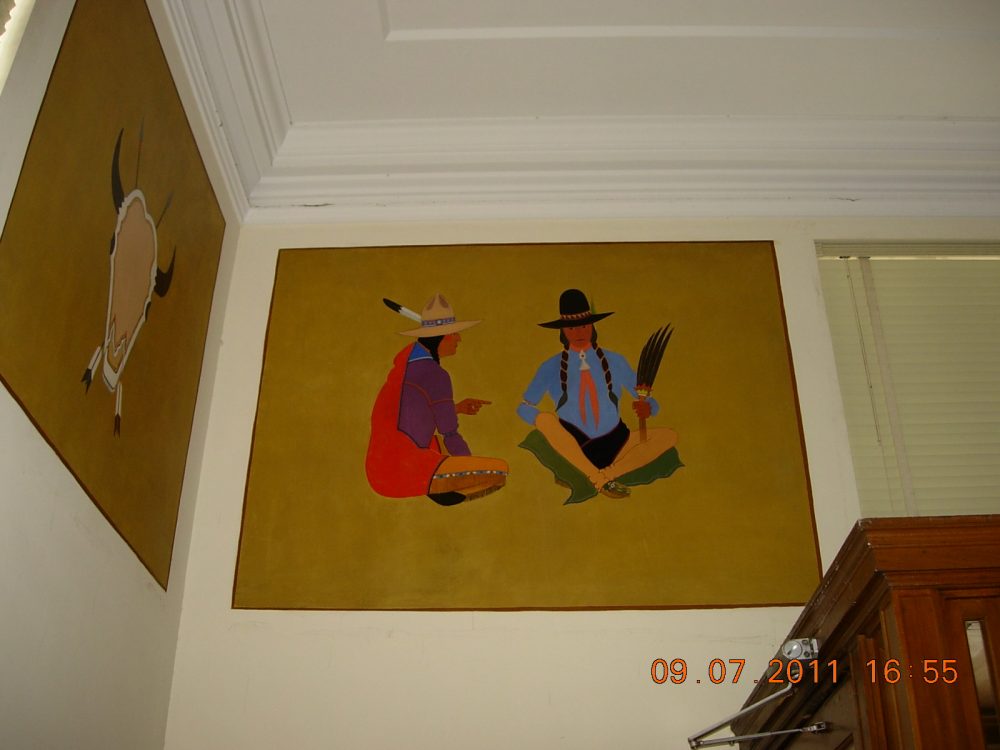
Two Eagle Dancers
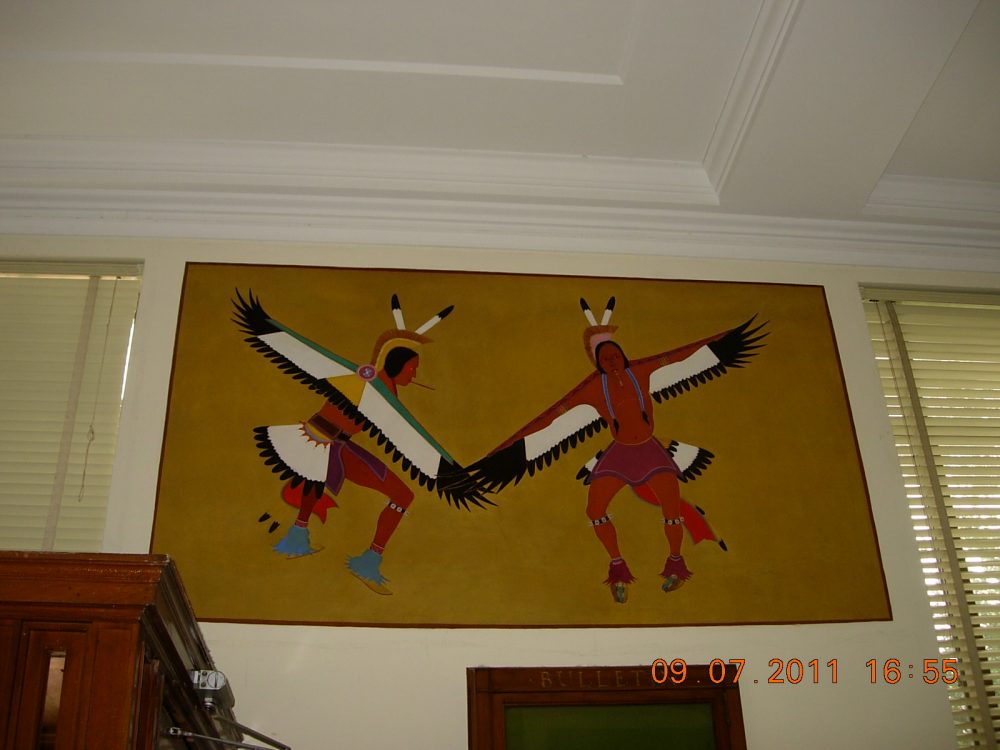
The Fancy War Dance and Cedar Wood Flute
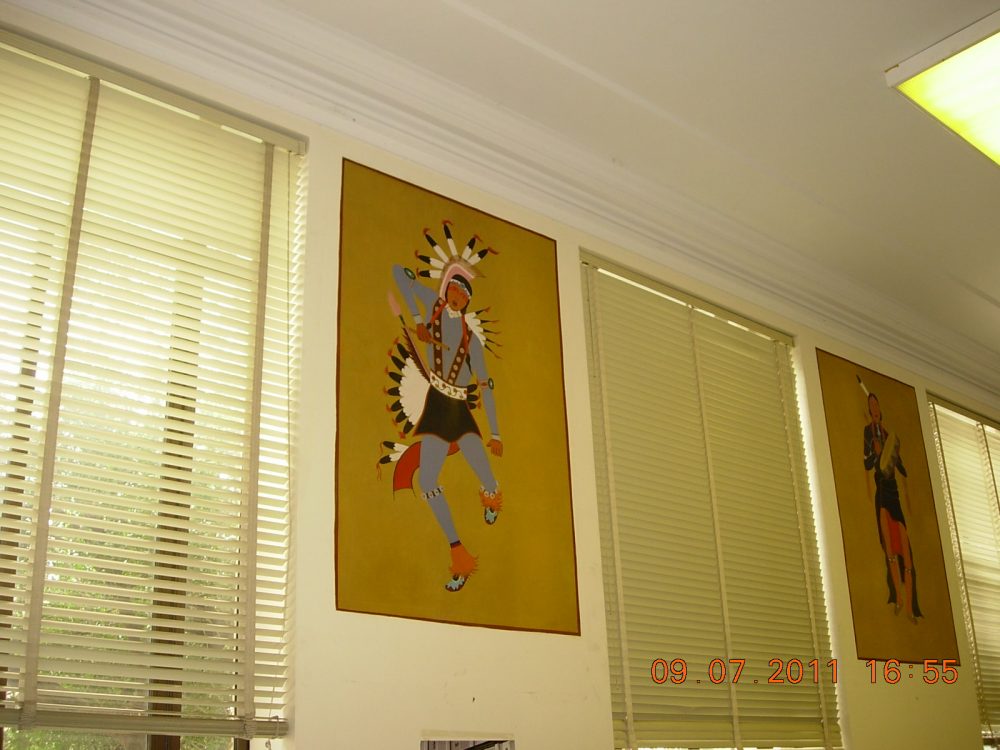
The Scalp Dance
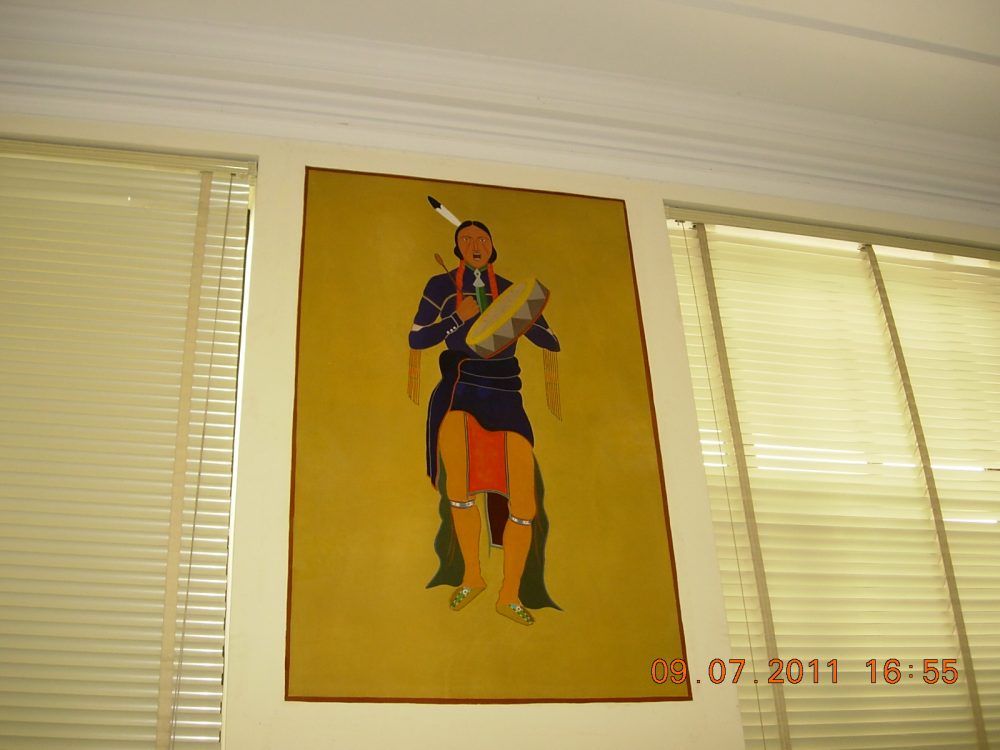
Individual War Dance Drummer
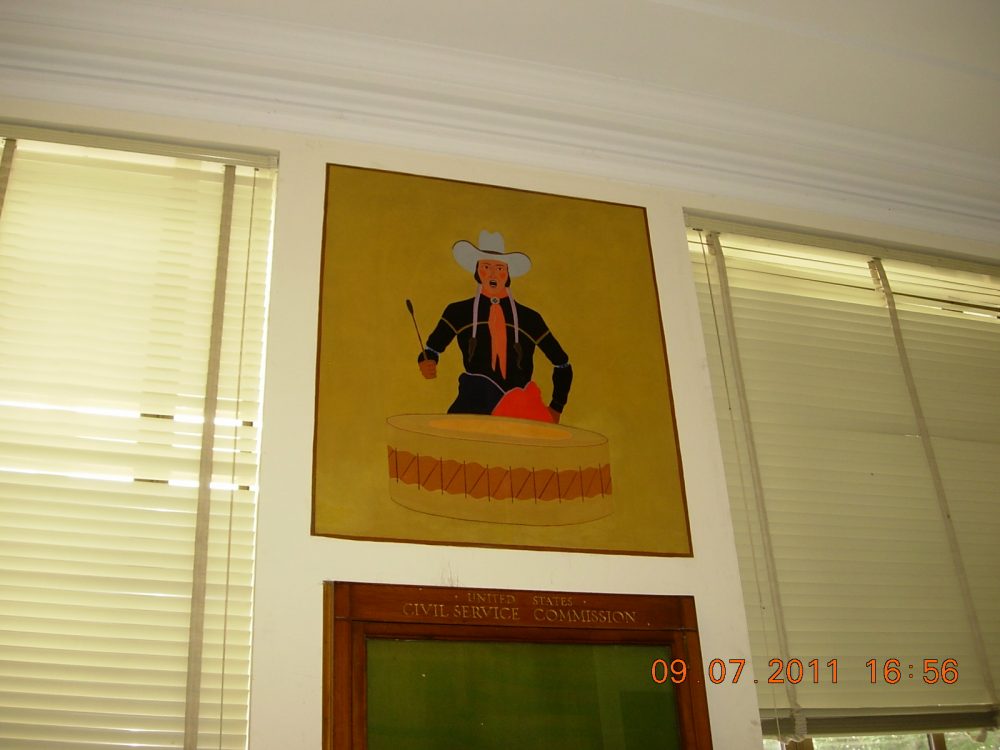
Two Women and Child Watching Dancers
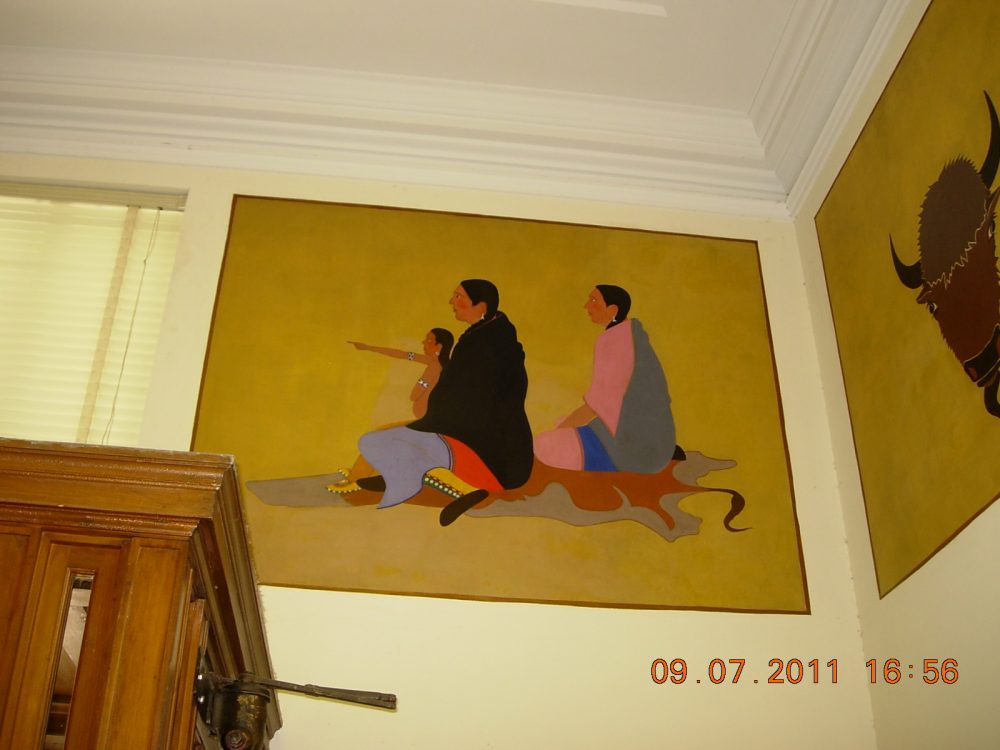
Three large murals depict the Kiowas preparing to move south for the winter. “Kiowas Moving Camp” and “Kiowa Camp Site” show the chores performed by the entire family and the activities during winter life.
Kiowas Moving Camp
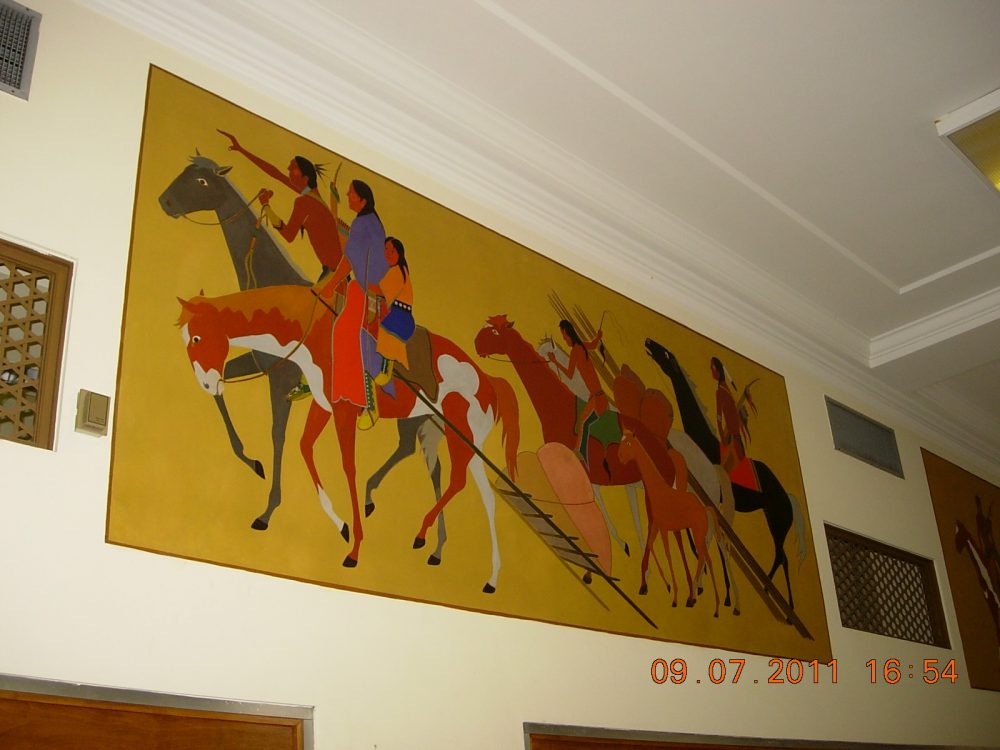
Kiowa Camp Site
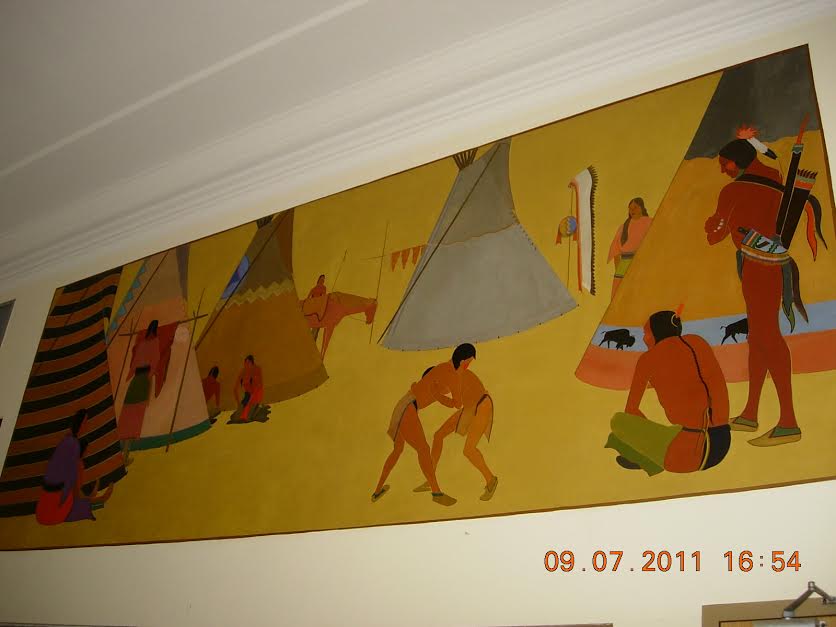
Buffalo Hunting Scene
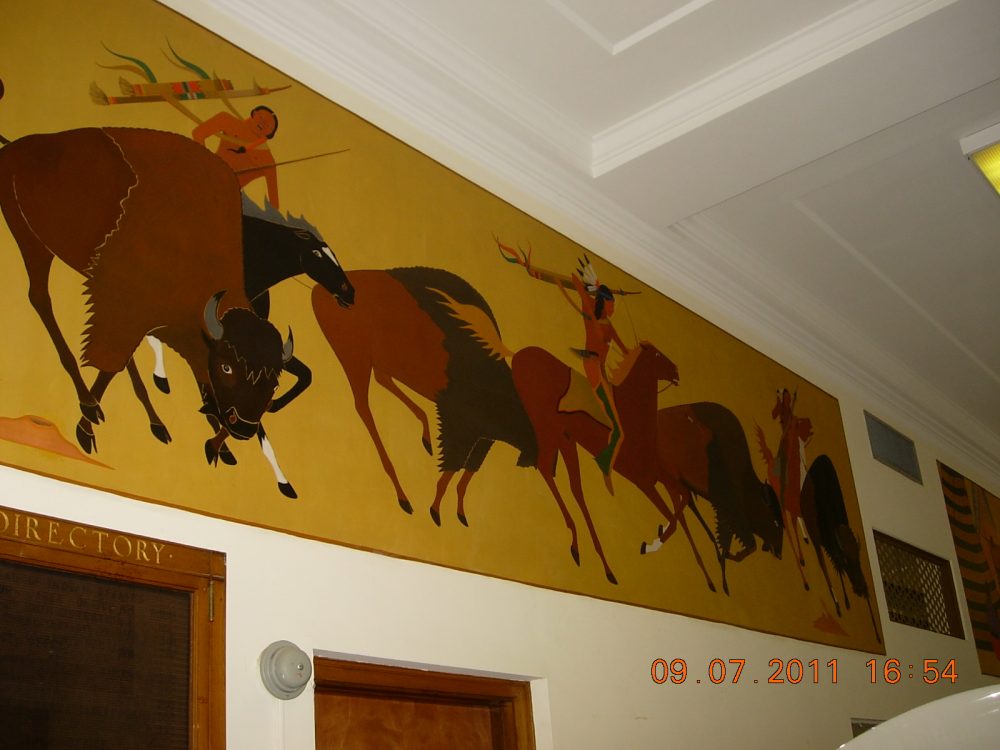
Buffalo with Crossed Arrows Behind It
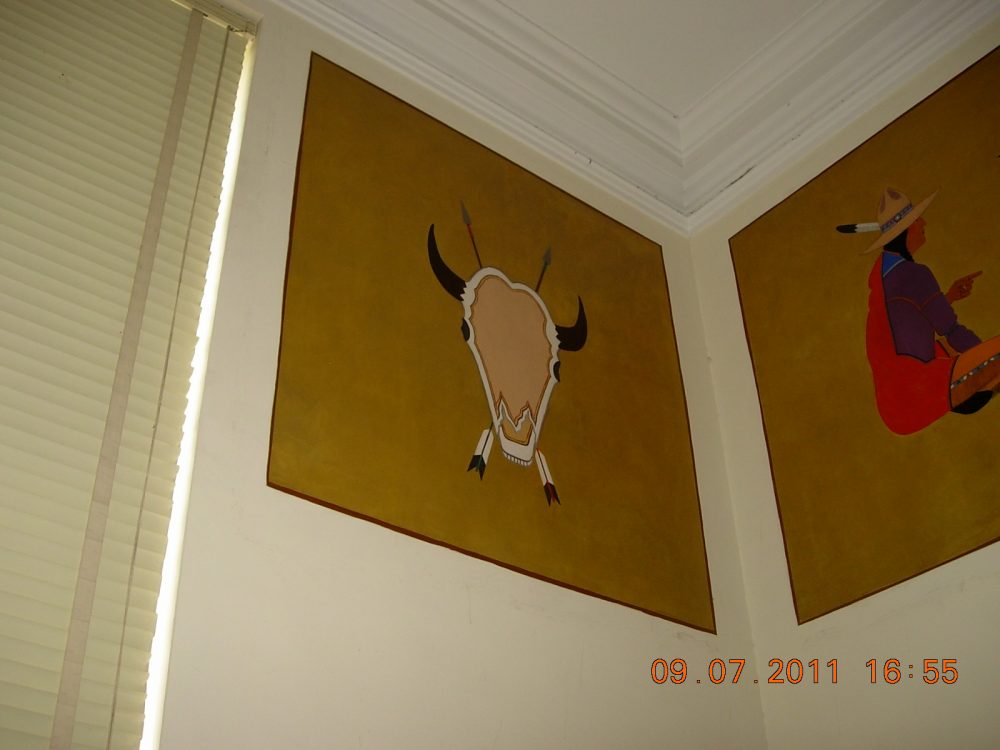
Buffalo Hunter Shield
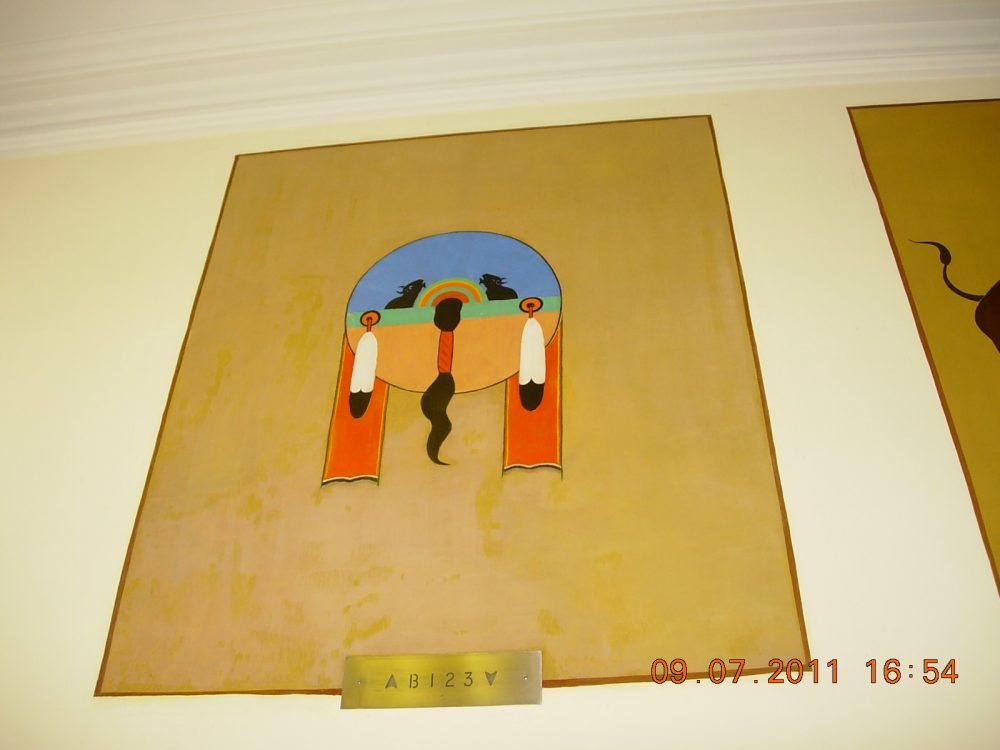
Fresh Buffalo Head

Indian Mother and Child in Cradle

Sources:
- Treasury Department Art Projects Bulletin, no. 14 (July 1937-January 1938), p.23, in Holger Cahill Papers, Archives of American Art, reel 5290, frame 899.
- https://postalmuseum.si.edu/indiansatthepostoffice/mural2.html
- The Living New Deal
- Thematic Survey of New Deal Public Art of Oklahoma 2003-2004, Project Number: 03-401.
- https://smarthistory.org/mopope-murals-anadarko/



Recent Comments